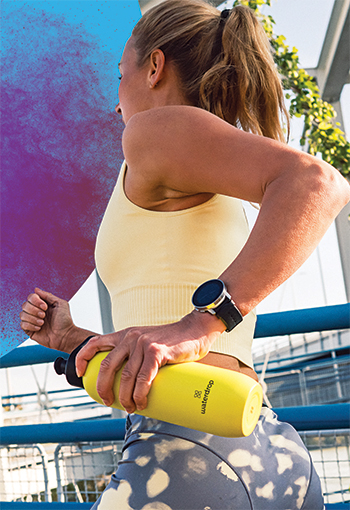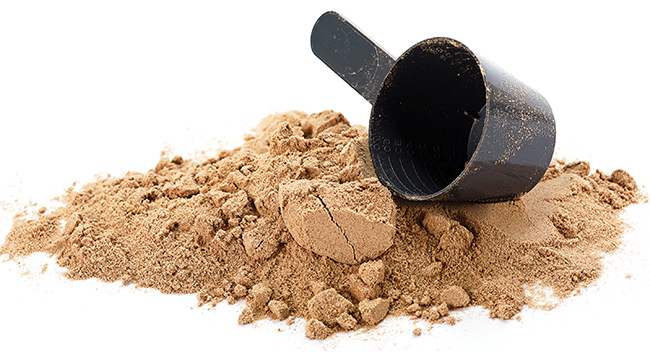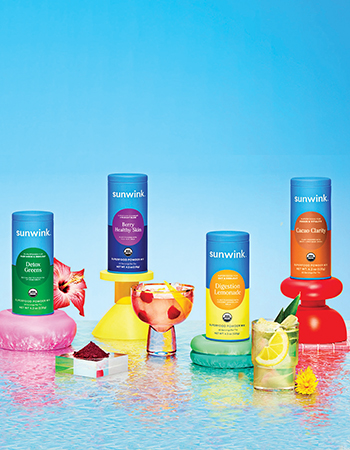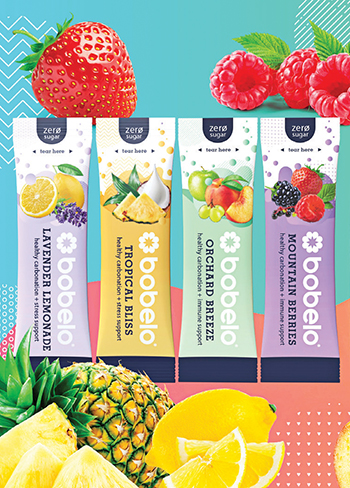Mixing It Up: Powders Make Jump From DTC into Retail
A category once dominated by water-flavoring brands like Crystal Light and Kool Aid and the earliest versions of Gatorade is evolving by bringing not only advanced functional ingredients into the mix but a retail approach that moves these mix-to-drink products beyond the beverage aisle and onto shelves throughout the store.
From coffee alternatives and wellness-focused drinks to new takes on hydration mixes, powdered beverage brands are making the jump to omni-channel distribution by not just offering a more convenient way to consume beverages but also by finding ways to adapt retail strategies, formats and marketing to reach customers in-store.
Drink mix revenue generation shot up during the COVID-19 pandemic as health-conscious consumers looked for powdered beverages promoting immunity. A recent report from market research firm Grand View Research estimates that the powdered beverage category will reach $94.8 billion by 2030. Supermarkets dominated the sales mix with 40% of retail channel sales in 2021. Between 2022 and 2030, the coffee-based segment of powdered beverages is expected to grow at the second fastest rate – 2.5% CAGR, the report suggests.
Hydration stick maker Liquid I.V. has risen to the top of the sports drink mix category by capitalizing on Unilever’s management and reach into mainstream channels. According to Circana (formerly IRI) research data, the brand brought in $258.6 million in sales in the 52-week period ending February 26, a 94.3% increase year-over-year.
Even smaller brands in the powdered category like Trulabs, which produces fitness-oriented drink mixes that aid in hydration, energy, pre-workout and sleep, have made big jumps in sales. Trulabs grew 2266.3% in dollar sales in the 52-week period ending February 26, after moving into Walmart 6 months earlier. The brand’s sales represent a small portion of the larger sports drink mix category but a significant milestone for an up-and-coming brand.
New powdered brands tend to favor ecommerce and DTC channels because margins can be higher online. Some functional drink mixes, like Athletic Greens, which pulled in $115 million in January, have even leaned further into DTC with seemingly few plans to go into traditional retail. Yet, most digital-first powdered brands are looking towards retail as the best way to increase market share and bring functional drink mixes into the mainstream.
Retail Execution Is More Than Getting Powdered Products On Shelf
Max Baumann, CEO of retail food and beverage sales consulting company Basemakers, has been impressed with the variety of new brands using powdered formats. Drinkable oatmeal brand Oats Overnight has broken in both a new category but also has shown how a brand can rethink its DTC packaging to fit a retail distribution model, Baumann said.
“How do they [Oats Overnight] have packaging that stands out and doesn’t just get confused for oatmeal and have consumers use it the wrong way? They develop this powder and a ready-to-drink bottle and place it next to the other oat products [on shelf],” Baumann said. “They’ve seen tremendous success with that. Being in the bottle, they’re able to showcase that this is a drinkable oat shake.”
Developing unique retail-ready packaging might bring more production costs to a DTC brand but if it stands out enough on the shelf, the payoff could be new customers.
For Oats Overnight this decision took the brand out of the juice mixes and hydration supplements sections of the store and into the cereal aisle next to other breakfast items. It opens the brand up to a unique format of a familiar product – in this case a drinkable oatmeal.
MUD\WTR is another powdered beverage that has had a successful run as a digitally-native brand that launched in 2018. The company built itself as a lower-caffeine, coffee alternative powder that utilizes the functional benefits of cacao, rooibos tea, matcha and adaptogenic mushrooms.
In the last 12 months the brand reported that it had 442,508 active customers and about 1.4 million units sold during 2022. As the brand gears up this year to expand its in-store footprint beyond the several hundred accounts it currently has in the specialty channel, it is looking to distribute MUD\WTR products in a way that really tells the story of the brand.
A good partner would be willing to create a MUD\WTR set within the coffee section competing with coffee, tea and other hot beverages, said MUD\WTR CMO Mike Fox. He is confident that the brand equity built in the digital world will translate to success on grocery store shelves as long as it is placed in the right part of the store.
“The plan isn’t to suddenly explode into retail, with a huge sales team and massive distribution,” he added. “Us digital brands like to crawl, walk, run, test and iterate our way into much more effective ways to do things.”
That most especially relates to pack size. A typical 30-serving tin of MUD\WTR online runs $30, a much higher price than many conventional grocery shoppers are willing to spend on a new product in-store. Fox said MUD\WTR is currently testing how it can repackage its products from the 30-serving tin into a smaller format so retail customers can familiarize themselves with the product on a trial basis.
For MUD\WTR, DTC remains the “core of the business”, Fox said. “I don’t think we found the ceiling in DTC yet. We’re still growing and we’re still expanding…Retail is a nice complement.”
It’s also looking to expand its consumer base a bit. Recently the company reframed its marketing for a broader swath of consumers, launching a new campaign to “create healthy minds through healthy habits” with targeted ads online. The question is how to translate that campaign and its existing branding onto store shelves.
DTC As The Testing Ground For Mainstream Distribution
Some brands look at DTC as a jumping off point for larger growth in retail. Functional tonic and powder brand Sunwink has found that it could build a good following for its superfood, gut-health products in DTC but that it could then amplify sales in physical retail.
The brand launched with bottled tonics in 2019, but found a following online during COVID as consumers were looking for more functional powdered beverages to use at home.
“We got very close to the consumer and the consumer said: I love this whole superfoods base, can you give me something I can put in my smoothie or drink in water,” CEO and co-founder Eliza Ganesh said.
The powder line initially launched online in 2021, but in order to scale properly, needed retail distribution to achieve its full potential, Ganesh said. By 2022, the powders were available nationwide in Target and are continuing to expand this year with more national partnerships slated for the summer.
“The problem with DTC is you always have to push people to your website,” Ganesh said. “Whereas in retail, if you launch nationally in a retailer and you’re on-shelf then people can also discover you that way.”
Ecommerce and DTC provided a way for consumers to learn more about the product, post and read reviews, and familiarize themselves with the format, but the bulk of the business now comes from retail, Ganesh said.
Between its tonics and powders, Sunwink has entered around 5,000 doors nationwide. Ganesh attributes its success to having a “consumer-led” business model that tries to find ways to meet its customers where they need the brand to be.
“It’s one of the reasons we’re talking about stick packs now,” she said. “If people are going to take the full tin in their suitcase while they’re traveling, that’s telling you something, they want the travel opportunity, they want the stick packs.”
Innovating A Familiar Segment of Powders
Austria-based waterdrop has used that same approach of learning from its online consumers to figure out its next stage of growth strategy.
“We’re a community-loved brand, meaning we have 100,000 people in social media groups, exchanging with the brand every day. Circulating ideas and circulating feedback,” waterdrop co-founder Henry Murray said.
Many of the products, like a hot beverage mix and an app built to track a consumer’s hydration were launched from community-led feedback, Murray said.
The brand recently closed a $70 million Series B funding round led by private equity firm Temasek to help build out its network of distribution in the U.S. Waterdrop recently announced it was now available in over 3,000 stores in the U.S. including 2,051 Walmart And 130 Target locations. Yet, the brand sees opportunity in not only traditional retail channels but branded waterdrop stores.
The stores as well as the waterdrop app allow the company to communicate directly with customers getting “one-to-one feedback” that fuels innovation, Murray said.
Innovation might not only relate to distribution strategy, product type or format, but also manifests in being flexible and letting a product naturally evolve. Stephen Colvin conceptualized the idea for a business-to-business sparkling hydration stick while working as a retail and channel strategy manager at Talking Rain’s Sparkling Ice brand between 2016 and 2018.
The initial strategy for his brand, Bobelo, was to influence buying habits by familiarizing customers with the product in tech company office settings so “when we did go (Business-to-Consumer), we would already have a built-in network of consumers,” he said.
Unfortunately, timing was not on the brand’s side. Bobelo launched in January 2021 and within the next three months, COVID’s impact on office culture had driven Colvin to pivot to reaching consumers at home.
“It was kind of a slow slog to adapt from BTB to BTC because we had to rebuild everything,” he said. “We had to build everything from scratch in the middle of the pandemic. It was not the funnest experience.”
It meant building out variety packs, multi-pack boxes and trial sizes that would fit a DTC and ecommerce model; a far cry from the BTB strategy of single Bobelo sticks housed on bamboo shelves intended for office break rooms. In the end, the experience allowed the brand to learn what consumers were looking for in powdered beverages. It has since expanded its line from immunity and stress-relief to a clean energy powder that is about to expand with four new flavors.
That category is on the rise. According to Circana’s data, the single-serve, energy drink mix category brought in nearly $193 million in sales in the 52-week period ending February 26, showing a 28.6% growth year-over-year. Rapidly growing energy drink brand Celsius, known for its RTD cans, sold $43.5 million in energy stick mixes, a 156.1% rise from the previous year.
Revamped Bobelo is starting its move into retail with commitments to roll out into about 300 conventional grocery stores in its home market of Utah, Arizona and the Mountain region. Colvin hopes to reach 500 stores by the end of the summer by eyeing club and discount dollar stores, where he believes the brand has an opportunity as a functional alternative to other powders sold in those channels.
The relationship between DTC and in-store retail works both ways as well. Existing digital customers might buy more when they see a familiar product on a shelf, or new customers might try a product and then search for it online, creating a feedback loop in both directions. Baumann used digital-first eyeglasses company Warby Parker as an example of how powdered functional beverages could utilize DTC to impact retail and vice-versa.
“When they [Warby Parker] started opening up their own retail shops, they not only saw sales for the shop go up but their sales online went up,” he said. “It’s kind of that billboard effect in the community; people discovering it in-person and then when they want to reorder a pair, instead of going into the store, they buy it online.”


Receive your free magazine!
Join thousands of other food and beverage professionals who utilize BevNET Magazine to stay up-to-date on current trends and news within the food and beverage world.
Receive your free copy of the magazine 6x per year in digital or print and utilize insights on consumer behavior, brand growth, category volume, and trend forecasting.
Subscribe


